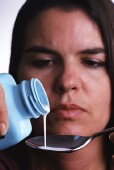
MONDAY, Sept. 24 (HealthDay News) — Use of certain antibiotics may put children at higher risk for developing bowel diseases, new research has found.
The earlier children take antibiotics and the more they take, the higher the risk of later developing the inflammatory bowel diseases known as Crohn’s disease and ulcerative colitis, the researchers found.
“There appears to be a ‘dose response’ effect,” said Dr. Matt Kronman, assistant professor of pediatric infectious diseases at the University of Washington School of Medicine in Seattle. “The more antibiotics children took, the more their risk increased.”
Earlier studies had suggested a link between bowel disease and antibiotics use, but most of those studies had limitations. The new study, published online Sept. 24 in the journal Pediatrics, looked at data on more than 1 million children 17 years old or younger in nearly 500 health practices participating in a United Kingdom health network. The children were followed for two or more years between 1994 and 2009.
The researchers found that 64 percent of the children had taken some sort of antibiotic at least once, and about 58 percent had taken antianaerobic antibiotics, which target bacteria that do not need oxygen to grow. Antianaerobic antibiotics include penicillin, amoxicillin, tetracyclines, metronidazole, cefoxitin and others.
During the follow-up period, nearly 750 children developed Crohn’s or ulcerative colitis. Common symptoms of these lifelong conditions include abdominal pain, diarrhea and weight loss. The risk was more than five times greater for babies given the drugs before 1 year of age compared to babies who did not receive antibiotics, but the risk decreased significantly with age.
Although there was an 84 percent increased risk of developing the bowel diseases for those who took antibiotics, the real-world risk is still very low, Kronman said. Also, although the study found an association, it did not establish a cause-and-effect relationship, so parents should not deny their children needed medication based on these results, experts said.
In the United States, about 49 million prescriptions for pediatric antibiotics are written each year, about half of them for penicillin, according to background information in the study. The authors said those prescriptions would be associated with 1,700 additional cases of irritable bowel disease a year.
It is known that antibiotics change the natural bacterial environment of the gut, and Kronman speculates that this may trigger inflammation. The bowel diseases are marked by chronic intestinal inflammation.
“Our study lends credence to that hypothesis,” he said. But the authors said many questions still remain.
Kronman suspects the antianaerobic antibiotics are driving the boost in risk. “The vast majority of bacteria in the gut are anaerobic,” he said.
They found no link, however, between tetracycline, an antianerobic antibiotic, and bowel disease.
The large number of children studied is a strength of the new research, said another expert, Dr. William Muinos, co-director of gastroenterology at Miami Children’s Hospital and assistant professor of pediatrics at Florida International University in Miami.
Muinos said he has observed the link in patients. It appears to him that drugs that disrupt more of the anaerobic colonies are worse for increasing the risk of bowel disease.
The take-home message, Kronman said, is not to avoid antibiotic use in children at any cost but to use them wisely. “When they are needed, they are critical,” he said.
Parents should feel free to ask a doctor who is prescribing an antibiotic for their children if it’s needed at that time, Kronman added. Parents also can consider asking doctors if they can choose a targeted antibiotic that focuses on a narrower range of bacteria.
One message for parents, he said, is to tell your child’s pediatrician if you have a family history of Crohn’s disease or ulcerative colitis.
More information
To learn more about antibiotic use in children, visit the American Academy of Pediatrics.

